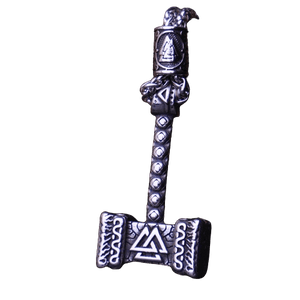Ouroboros: The Eternal Cycle of Norse Mythology
- min of reading
Summary :

Nordic Wolf Celtic Ring
£26.28

Wolf Head Necklace
£26.28

Celtic Entwined Ring
£29.84

Celtic Triskel Bracelet
£26.28
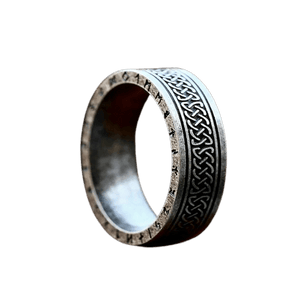
Viking Rune Ring
£29.84
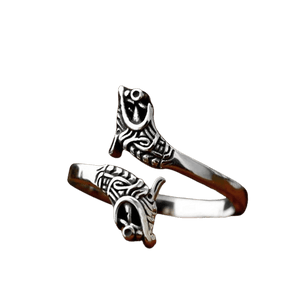
Celtic Wolf Ring
£26.28
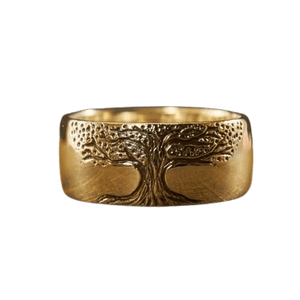
Tree of Life Ring
£26.28
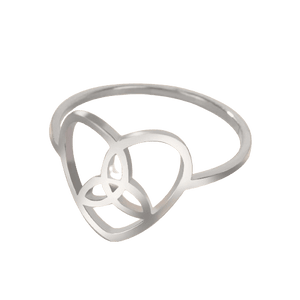
Trique Heart Ring
£26.28
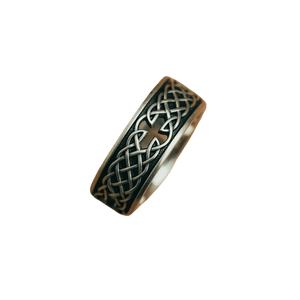
Celtic Ring
£26.28
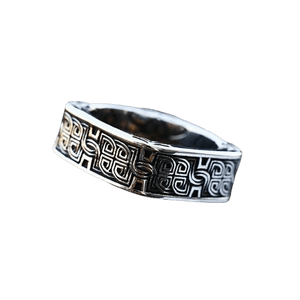
Celtic Ring
£26.28

Claddagh and Triskel Ring
£26.28
Ouroboros , a mystical symbol that transcends the boundaries of time, space, and mythology. Although often associated with esoteric traditions, Ouroboros also holds an important place in rich Norse mythology . This tail-biting serpent, a visual representation of the eternal cycle , finds its roots in ancient thought and profound symbolism.
Origin of the Word "Ouroboros"
Before diving into the specific role of Ouroboros in Norse mythology, it is essential to understand the origin of the word itself. The term “ Ouroboros ” derives from ancient Greek, where “ oura ” means “ tail ” and “ boros ” means “ to eat .” Together, this creates the powerful image of the “ tail that eats itself ,” symbolizing the eternal cycle of life, death, and regeneration .
This striking visual representation offers a profound perspective on the cyclical nature of time. In ancient Greek thought, the Ouroboros serpent was often interpreted as a symbol of eternal renewal, where each ending marks the beginning of a new cycle. This conception resonates in many cultures around the world, but it takes on particular significance in the context of Norse mythology.
Imagine the snake biting its own tail as a visual metaphor for continuity, an unbroken connection between the stages of life and death. The ancient Greeks saw this image as representing perpetual self-renewal, a concept that resonates with Norse philosophy and wisdom, where cosmic cycles are revered and respected.
Ouroboros in Norse Mythology
In Norse mythology, Ouroboros is depicted in various forms, often related to the concepts of cosmic cycles and the cyclical nature of time . It embodies duality , continuity , and eternal recommencement .
This mystical serpent, coiled around iconic elements such as Yggdrasil, the World Tree, becomes the silent witness to the eternal cycles of creation and destruction . The ancient Norse saw in Ouroboros a powerful symbol of the inherent duality of existence, where life and death coexist in perpetual balance.
The representation of Ouroboros in Norse mythology goes beyond a simple image. It evokes profound notions of transcendence and intimate connection with the divine . Some myths describe the serpent as a guardian of the gates of time, watching over the natural cycles of creation, preservation, and dissolution .

Yggdrasil and Ouroboros
A fascinating aspect of Ouroboros' role in Norse mythology is its connection to Yggdrasil, the World Tree. Yggdrasil is the central axis of the Norse universe, and Ouroboros, sometimes depicted as a serpent coiled around the tree, symbolizes the link between the past, present, and future .
This powerful image creates a striking visual representation of cosmic continuity . Ouroboros, by wrapping itself around Yggdrasil, becomes the guardian of ancient wisdom, reminding us that knowledge and destiny are woven into the very roots of existence. The ancient Norse saw this connection between the serpent and the tree as a metaphor for life itself, extending through the ages and inextricably connecting each moment.
Ouroboros' connection with Yggdrasil also highlights the symbiosis between the spiritual and material worlds . By representing the duality of time, the serpent and tree together express the idea that life and spirituality are intrinsically linked, with each experience shaping the other in a cyclical manner.
Symbolism of Ouroboros
The symbolism of Ouroboros in Norse mythology transcends its mere physical representation to delve into themes of extraordinary depth. Far beyond the image of the serpent biting its own tail, Ouroboros evokes essential concepts such as the duality of time , regeneration , and perpetuity .
In the rich tapestry of Norse myths, Ouroboros holds a special place as the guardian of temporal mysteries. Some tales depict this serpent as the guardian of the gates of time , an entity watching over the passages between eras, carefully monitoring the natural cycles of creation and destruction .
This vision of the serpent as a temporal guardian adds an additional layer of meaning to its mythological role. Ouroboros then becomes not only a symbol of cosmic continuity, but also a spiritual guide through the twists and turns of time. Its eternal coiling suggests an intimate connection with the cyclical forces of the universe , orchestrating an infinite ballet between beginning and end, birth and death.
Throughout the ages, the Nordic peoples have seen in Ouroboros much more than a mere artistic representation. It was an invitation to understand the intricacies of eternal time and to embrace the inescapable nature of the cycles of creation and destruction . By contemplating this serpent, they sought to unravel the secrets of the universe, to grasp the invisible threads that weave the fabric of destiny, and to find an echo of their own existence in the infinite myth of Ouroboros.
The Three Ages of the World
In Norse cosmogony, the world passes through three distinct ages, each preceded by a great cataclysm. Ouroboros, as a symbol of the infinite cycle , is closely linked to this tripartite view of time. Some myths suggest that the serpent bites its tail at the end of each era, thus marking the transition to a new age.
This tripartite vision of the Nordic world, often described as the Three Ages , finds in Ouroboros a profound symbolic representation. At the end of each era, the serpent biting its own tail embodies the cyclical nature of time, where the transition between ages is inextricably linked to regeneration and rebirth.
The fact that the serpent is associated with the end of each era underlines its nature as the guardian of cosmic cycles . It embodies the ancient wisdom that guides the world through its transformations, offering a reassuring perspective on the continuity of existence despite cataclysmic upheavals.
Some Norse myths go so far as to describe Ouroboros as the phenomenon of transition itself, depicting the serpent as the focal point where old and new energies converge, giving birth to a new age. This view of transition as a cyclical process reinforces the idea that, in Norse cosmogony, every ending is also a new beginning .
Ouroboros and the Norse Deities
Several Norse deities are associated with Ouroboros in some way. Odin, the supreme god, is sometimes depicted contemplating the serpent as an oracle of fate . Similarly, Jormungandr, the giant sea serpent, is sometimes interpreted as a physical manifestation of Ouroboros.
The connection between Odin and Ouroboros underscores the link between divine wisdom and the eternal cycle . Odin, as a primordial figure in Norse mythology, seeks to understand the mysteries of the world, using the symbol of Ouroboros as a means to contemplate the workings of fate. This association reinforces the perception of the serpent as a source of transcendental knowledge .
Jormungandr , on the other hand, embodies a more physical interpretation of the serpent. As a giant sea serpent , he represents a tangible manifestation of Ouroboros, swimming through the turbulent waters of Norse mythology. His very existence embodies the duality of Ouroboros, as both a terrifying creature and, simultaneously, a keeper of cosmic secrets.
These connections between the Norse deities and Ouroboros highlight the complexity of the relationship between the divine and the cyclical . The serpent becomes a symbolic bridge between the realm of the gods and the very fabric of existence, offering a fascinating perspective on how Norse mythology integrates the symbolism of Ouroboros into the divine pantheon.
The Quest for Knowledge
Ouroboros is also linked to the search for knowledge and infinite wisdom . Some accounts suggest that those who manage to understand the symbolism of the serpent gain insight into the mysteries of the universe and destiny .
In the endless quest for understanding, the serpent biting its own tail becomes a gateway to transcendental revelations . Those who meditate on its symbolism are considered seekers of esoteric knowledge , delving into the depths of cosmic secrets that only Ouroboros seems to hold.
The symbolism of Ouroboros as the guardian of knowledge is found in many Norse mystical traditions. Some texts suggest that understanding the serpent offers not only insight into the workings of the cosmos , but also into the complex workings of individual destiny .
By embracing the quest for knowledge linked to Ouroboros, Norse initiates seek to transcend the limits of human understanding, seeking the eternal wisdom that lies beyond the veils of the material world.
Conclusion
In conclusion, Ouroboros holds a significant place in Norse mythology, symbolizing the cyclical nature of time, life, and death. Its close connection to key elements such as Yggdrasil, the Norse deities, and the quest for knowledge makes it a symbol rich in meaning and depth.
As ancient Norse wisdom so aptly describes, Ouroboros represents infinite continuity, where each ending marks the beginning of a new cycle. It is a powerful reminder of the constancy of change and the perpetuity of life.
As we contemplate Ouroboros, we are invited to reflect on the cycles of our own lives, embrace change, and find wisdom in understanding the eternal nature of the flow of time.

